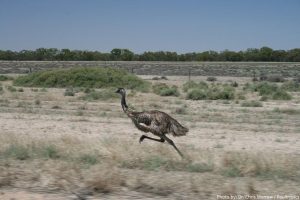 These days, it seems we are all aware of what an emu is, probably due to the Liberty Mutual commercials that are out there, but in 1932 Australia, these were a nuisance bird. They were everywhere and they were not popular. In fact, they were running amok in the Campion district of Western Australia, and the public was very concerned. They had made several attempts to curb the growth of the emu population, including the Australian soldiers being armed with Lewis guns…leading the media to adopt the name “Emu War” when referring to the incident. While a number of the birds were killed, the emu population persisted and continued to cause crop destruction.
These days, it seems we are all aware of what an emu is, probably due to the Liberty Mutual commercials that are out there, but in 1932 Australia, these were a nuisance bird. They were everywhere and they were not popular. In fact, they were running amok in the Campion district of Western Australia, and the public was very concerned. They had made several attempts to curb the growth of the emu population, including the Australian soldiers being armed with Lewis guns…leading the media to adopt the name “Emu War” when referring to the incident. While a number of the birds were killed, the emu population persisted and continued to cause crop destruction.
After World War I ended, the Australian government gave land to large numbers of ex-soldiers from Australia and the UK. The purpose of the gift was to take up farming within Western Australia, often in areas that had been counterproductive. When the Great Depression hit in 1929, these farmers were encouraged to increase their wheat crops. The government promised assistance in the form of subsidies, but later failed to deliver. In spite of the recommendations and the promised subsidies, wheat prices continued to fall, and by October 1932 matters were becoming critical, with the farmers preparing to harvest the season’s crops and threatening to refuse to deliver the wheat.
To make matters, the area was hit with the arrival of as many as 20,000 emus. This is apparently an annual event as the emus regularly migrate after their breeding season, heading to the coast from the inland regions. With the cleared land and additional water supplies being made available for livestock by the Western Australian farmers, the emus decided that the farmlands were a good, and closer habitat, and they began to foray into farm territory, especially in the marginal farming land around Chandler and Walgoolan. The emus began to eat and spoil the crops. In addition, they left large gaps in fences where rabbits could enter and cause further destruction.
When the farmers relayed their concerns about the birds ravaging their crops, and a group of the ex-soldiers were sent to meet with the Minister of Defense, Sir George Pearce. Something had to be done. Having served in World War I, the soldiers-turned-settlers were well aware of the effectiveness of machine guns, and they requested their deployment to fight this new enemy. The minister readily agreed, although with conditions attached: the guns were to be used by military personnel, troop transport was to be financed by the Western Australian government, and the farmers would provide food, accommodation, and payment for the ammunition. The farmers agreed and Pearce also supported the deployment on the grounds that the birds would make good target practice, while some in the government viewed the operation as a way of being seen to be helping the Western Australian farmers, as a way of staving off the secession movement that was brewing.
Sir George Pearce, who was later referred to in Parliament, as the “Minister of the Emu War” by Senator James Dunn, ordered the army to selectively thin the nuisance emu population…by large numbers. The “war” was scheduled to begin in October 1932, under the command of Major G P W Meredith of the Seventh Heavy Battery of the Royal Australian Artillery. Meredith was supposed to use troops armed with two Lewis guns and 10,000 rounds of ammunition, but the operation was delayed by a period of rainfall that caused the emus to scatter over a wider area. The rain finally stopped by November 2, 1932, and the troops were quickly deployed with orders to assist the farmers and, according to a newspaper account, to collect 100 emu skins so that their feathers could be used to make hats for light horsemen. On November 2nd, the men travelled to Campion, where some 50 emus were sighted. Unfortunately, when they got there, the birds were out of range of the guns. The local settlers attempted to herd the emus into an ambush, but the birds split into small groups and ran so that they were difficult to target. Nevertheless, while the first attack from the machine guns was ineffective due to the distance from the targets, a second round of gunfire was able to kill “a number” of birds. Later the same day, a small flock was encountered, and “perhaps a dozen” birds were killed.
The next significant event was on November 4th, when Meredith established an ambush near a local dam. More than 1,000 emus were spotted heading towards their position. This time the gunners waited until the birds were in close proximity before opening fire. The gun jammed after only twelve birds were killed and the rest scattered before any more could be shot. No more birds were sighted that day, so the decision was made to move further south, where the birds were “reported to be fairly tame.” The group had only limited success in spite of Meredith’s efforts. As the pursuit continued, it became apparent that “each pack seemed to have its own leader now…a big black-plumed bird which stands fully six feet high and keeps watch while his mates carry out their work of destruction and warns them of our approach.” In desperation, Meredith even went so far as to mount one of the guns on a truck. He was still ineffective, as the truck was unable to gain on the birds, and the ride was so rough that the gunner was unable to fire any shots, even if they had been able to get close. By November 8th, six days after the first attack, 2,500 rounds of ammunition had been fired. The number of birds killed is uncertain. One account estimates that it was 50 birds, but other accounts range from 200 to 500, the latter figure being provided by the settlers. Meredith’s official reported that there were no casualties among the men.
Summarizing the operation, ornithologist Dominic Serventy commented, “The machine-gunners’ dreams of point blank fire into serried masses of Emus were soon dissipated. The Emu command had evidently ordered guerrilla tactics, and its unwieldy army soon split up into innumerable small units that made use of the military equipment uneconomic. A crestfallen field force therefore withdrew from the combat area after about a month. On 8 November, members in the Australian House of Representatives discussed the operation. Following the negative coverage of the events in the local media, that included claims that “only a few” emus had died, Pearce withdrew the military personnel and the guns on 8 November.”
After the “Emu War” was over, Meredith compared the emus to Zulus and commented on the striking maneuverability of the emus, even while badly wounded. After the withdrawal of the military, the emu attacks on crops continued. Farmers again asked for support, citing the hot weather and drought that brought emus invading farms in the thousands. James Mitchell, the Premier of Western Australia lent his strong support to renewal of the military assistance. At the same time, a report from the Base Commander was issued that indicated 300 emus had been killed in the initial operation.
The killing continued periodically, with similar results. The Emu was just too fast, too aware, or too “lucky,” to be caught or killed. By December 1932, word of the Emu War had spread, reaching the United Kingdom.  Conservationists protested the cull as “extermination of the rare emu”. Dominic Serventy and Hubert Whittell, the eminent Australian ornithologists, described the “war” as “an attempt at the mass destruction of the birds”. Throughout 1930 and onward, the farmers tried exclusion barrier fencing as a means of keeping emus out of agricultural areas (in addition to other vermin, such as dingoes and rabbits). In November 1950, Hugh Leslie raised the issues of emus in federal parliament and urged Army Minister Josiah Francis to release a quantity of .303 ammunition from the army for the use of farmers. The minister approved the release of 500,000 rounds of ammunition. The emu continues to thrive today.
Conservationists protested the cull as “extermination of the rare emu”. Dominic Serventy and Hubert Whittell, the eminent Australian ornithologists, described the “war” as “an attempt at the mass destruction of the birds”. Throughout 1930 and onward, the farmers tried exclusion barrier fencing as a means of keeping emus out of agricultural areas (in addition to other vermin, such as dingoes and rabbits). In November 1950, Hugh Leslie raised the issues of emus in federal parliament and urged Army Minister Josiah Francis to release a quantity of .303 ammunition from the army for the use of farmers. The minister approved the release of 500,000 rounds of ammunition. The emu continues to thrive today.


One Response to The Great Emu War